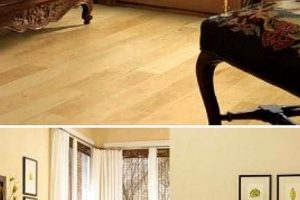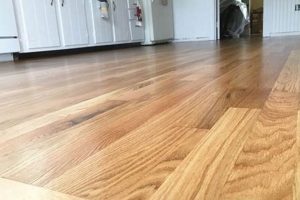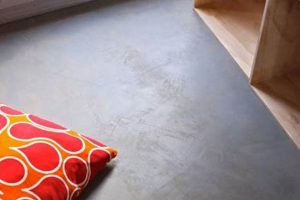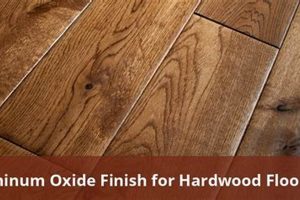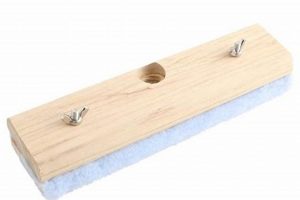A protective coating designed for wooden surfaces, particularly flooring, utilizes a synthetic resin dissolved in water as its primary carrier. This type of coating forms a durable, transparent layer that safeguards the wood from scratches, abrasions, and liquid penetration. For example, it’s commonly applied to hardwood floors in residential and commercial settings to enhance their longevity and appearance.
The significance of this coating lies in its ability to provide long-lasting protection while minimizing environmental impact. Compared to solvent-based alternatives, it exhibits lower volatile organic compound (VOC) emissions, contributing to improved air quality. Historically, solvent-based finishes were prevalent, but growing environmental awareness has driven the adoption of this more eco-conscious option, prized for its durability and ease of application.
The subsequent sections will delve into the specific characteristics, application techniques, maintenance procedures, and performance considerations associated with this increasingly popular surface treatment. Furthermore, comparisons will be drawn to other available floor finishes, highlighting the specific advantages and disadvantages inherent to its formulation.
Application Guidance for a Durable Floor Coating
The following recommendations provide practical advice for achieving a professional and long-lasting result when utilizing a specific type of water-borne protective sealant for wood floors.
Tip 1: Surface Preparation is Paramount. Ensure the wood floor is meticulously sanded to a uniform smoothness and free of any contaminants. Residual dust or existing finishes will compromise adhesion and final appearance.
Tip 2: Employ Proper Application Techniques. Use a high-quality applicator, such as a synthetic brush or microfiber roller, specifically designed for water-based products. Apply thin, even coats, avoiding excessive buildup that can lead to clouding or uneven drying.
Tip 3: Maintain Consistent Environmental Conditions. Optimal results are achieved within a temperature range of 65-75F (18-24C) and a relative humidity level between 40-60%. Deviations from these parameters can affect drying time and film formation.
Tip 4: Allow Adequate Drying Time Between Coats. Adhere strictly to the manufacturer’s recommended drying times. Premature application of subsequent coats can result in trapped solvents and a compromised finish.
Tip 5: Screen Between Coats for Optimal Smoothness. After each coat has fully dried, lightly screen the surface with a fine-grit abrasive pad (typically 220-grit or higher) to remove any imperfections and create a smooth surface for the next coat.
Tip 6: Consider a Moisture Barrier. When applying to floors over concrete slabs or in areas prone to moisture, consider using a moisture barrier under the wood flooring or incorporating a moisture-resistant primer before applying the finish.
Tip 7: Use Compatible Products. Ensure that all primers, sealers, and cleaning products used are specifically designed for compatibility with the coating to avoid adverse reactions and ensure the long-term integrity of the finish.
Adhering to these best practices will contribute significantly to a durable, aesthetically pleasing, and long-lasting protective layer on the wood floor, enhancing its resistance to wear and tear.
The subsequent sections will delve into the maintenance and long-term care of surfaces treated with this particular protective coating.
1. Durability
The durability of a floor finish directly influences its lifespan and ability to withstand daily wear and tear. For water-based polyurethane coatings, achieving optimal durability is a primary consideration for residential, commercial, and industrial applications. The following facets outline key aspects that contribute to the overall resilience of this type of floor finish.
- Abrasion Resistance
This characteristic dictates the coating’s ability to resist scratches and scuffs from foot traffic, furniture movement, and other forms of physical contact. Higher abrasion resistance translates to a longer-lasting finish that maintains its aesthetic appeal over time. Testing methods, such as the Taber Abraser test, quantify a finish’s resistance to abrasive forces. For instance, a finish used in a high-traffic retail environment necessitates a high abrasion resistance rating.
- Impact Resistance
Impact resistance refers to the coating’s ability to withstand sudden blows or impacts without cracking or chipping. Dropped objects, such as tools or heavy items, can compromise the integrity of a less resistant finish. In areas prone to such impacts, such as workshops or kitchens, a finish with high impact resistance is essential to prevent premature failure.
- Chemical Resistance
This facet assesses the coating’s ability to resist damage from exposure to various chemicals, including household cleaners, solvents, and spills. A chemically resistant finish prevents staining, discoloration, and degradation of the coating’s surface. For example, a floor finish in a laboratory or food processing plant requires excellent chemical resistance to withstand exposure to harsh cleaning agents and accidental spills.
- UV Resistance
Prolonged exposure to ultraviolet (UV) radiation from sunlight can cause discoloration and degradation of certain floor finishes. UV resistance prevents yellowing, fading, and loss of gloss over time. This is particularly important in areas with significant sun exposure, such as sunrooms or rooms with large windows. UV absorbers added to the finish formulation enhance its resistance to the harmful effects of UV radiation.
The inherent durability of water-based polyurethane floor finishes, encompassing abrasion, impact, chemical, and UV resistance, directly impacts the long-term performance and maintenance requirements of the floor. Selecting a finish with appropriate durability characteristics, tailored to the specific application environment, is critical for maximizing its lifespan and preserving its aesthetic appeal. Different formulations cater to varying levels of durability requirements, enabling informed decisions based on anticipated traffic, potential impacts, chemical exposures, and sunlight levels.
2. Application Techniques
Effective application techniques are inextricably linked to the performance and longevity of coatings. This relationship is particularly crucial when working with this specific type of floor finish. Improper application can negate the inherent advantages of the product, leading to premature failure, aesthetic imperfections, and increased maintenance requirements. The cause-and-effect relationship is direct: meticulous surface preparation, precise application methods, and controlled environmental conditions yield a durable, uniform, and visually appealing finish. Conversely, inadequate preparation, incorrect application techniques, or fluctuating environmental conditions result in a compromised finish.
Consider the case of a newly installed hardwood floor coated with a substandard application method. For instance, failure to properly sand and clean the surface before application leads to poor adhesion. Applying excessively thick coats can trap solvents and cause clouding or bubbling, while insufficient drying time between coats results in a soft, easily damaged film. These errors undermine the protective properties of the coating, making the floor susceptible to scratches, abrasions, and moisture damage. In contrast, a professional application involves thorough sanding, multiple thin coats applied with appropriate tools, and adherence to recommended drying times, resulting in a resilient and visually consistent surface. The practical significance lies in the reduced need for repairs, refinishing, and ultimately, lower long-term costs.
The application method is not merely a procedural step, but an integral component influencing overall performance. From surface preparation to the final curing process, each stage demands adherence to established best practices. Challenges in application, such as uneven coating, presence of air bubbles, or failure to achieve adequate film thickness, can substantially diminish the coating’s protective and aesthetic properties. Therefore, a comprehensive understanding of the application process, coupled with skilled execution, is paramount for realizing the full potential of this particular flooring solution. This understanding ties directly into the overarching goal of achieving a durable, aesthetically pleasing, and long-lasting floor finish.
3. VOC Content
Volatile Organic Compounds (VOCs) represent a significant consideration in the selection and application of coatings, including water-based polyurethane floor finishes. VOCs are organic chemicals that evaporate at room temperature, releasing fumes that can contribute to indoor air pollution and pose health risks. The selection of coating dictates the amount of VOCs released. Solvent-based polyurethanes traditionally exhibit high VOC levels. Water-based formulations, however, are engineered to significantly reduce VOC emissions, often by replacing organic solvents with water as the primary carrier. This substitution directly reduces the amount of harmful substances released during and after application, minimizing potential health impacts and environmental concerns.
Regulations and standards governing VOC emissions in coatings have driven the increased adoption of water-based polyurethanes. For instance, various jurisdictions impose limits on the allowable VOC content of architectural coatings, compelling manufacturers to develop compliant formulations. A practical example is the use of low-VOC floor finishes in schools and hospitals, where maintaining optimal air quality is paramount. Choosing a water-based polyurethane with a low VOC content ensures adherence to these regulations and contributes to a healthier indoor environment for occupants. Furthermore, the environmental benefits extend beyond indoor air quality. Reduced VOC emissions from coatings contribute to mitigating smog formation and reducing overall air pollution.
In summary, the VOC content is a critical parameter in evaluating water-based polyurethane floor finishes. Lower VOC levels translate to reduced health risks, improved air quality, and compliance with environmental regulations. The practical significance of understanding VOC content lies in the ability to make informed decisions that prioritize both performance and environmental responsibility. As regulations continue to tighten and awareness of the health impacts of VOCs increases, the selection of low-VOC water-based polyurethanes is expected to become increasingly prevalent in a variety of applications.
4. Maintenance Procedures
The long-term performance of floors treated with water-based polyurethane is directly correlated with the implementation of appropriate maintenance procedures. These procedures are not merely supplementary; they are integral to preserving the protective qualities and aesthetic appearance of the finish. The absence of proper maintenance leads to premature wear, necessitating costly repairs or refinishing, while consistent and correct upkeep extends the finish’s lifespan and retains its original luster.
Effective maintenance strategies encompass several key elements. Regular cleaning with pH-neutral cleaners formulated specifically for polyurethane surfaces prevents the accumulation of dirt, grime, and abrasive particles that can dull the finish. For instance, a commercial building with heavy foot traffic requires daily sweeping or vacuuming to remove debris, followed by damp mopping with a suitable cleaner. Furthermore, the use of walk-off mats at entryways minimizes the introduction of dirt and moisture, reducing the frequency of more intensive cleaning. Periodically, the application of a maintenance coat or refresher can restore the sheen and provide an additional layer of protection against wear. A real-world example is the routine maintenance performed on gymnasium floors, where specialized cleaning products and recoating schedules are implemented to withstand constant use and heavy impact.
Understanding the specific requirements of the water-based polyurethane finish is crucial for effective maintenance. Harsh chemicals, abrasive scrubbers, and excessive moisture can damage the finish, leading to discoloration, peeling, or cracking. Therefore, adherence to manufacturer-recommended cleaning protocols is essential. The implementation of these maintenance strategies presents a practical approach to maximizing the value and longevity of the flooring investment. Ignoring these procedures represents a false economy, ultimately resulting in increased costs and diminished floor performance.
5. Cost-Effectiveness
The economic viability of a floor finish is determined by a comprehensive analysis extending beyond initial purchase price. Evaluating cost-effectiveness necessitates considering factors such as material expenses, installation labor, long-term maintenance, and potential replacement costs. In the context of water-based polyurethane floor finishes, a higher upfront investment may be offset by lower lifecycle costs compared to alternative solutions. This relationship stems from attributes like enhanced durability, simplified maintenance, and reduced downtime for repairs. For example, selecting a more expensive, higher-quality polyurethane could decrease the frequency of re-coating, thereby lowering long-term maintenance expenditures and minimizing disruptions to business operations. A direct consequence of considering cost-effectiveness is the ability to make informed decisions that optimize budgetary allocations and maximize the return on investment.
The significance of understanding cost-effectiveness extends to practical applications in various settings. Consider a large commercial office space with high foot traffic. While a less expensive floor finish might seem appealing initially, its susceptibility to wear and tear could lead to frequent repairs and replacements, resulting in substantial cumulative costs. Conversely, investing in a durable, water-based polyurethane finish, despite its higher initial price, could minimize these expenses due to its enhanced resistance to abrasion and impact. Furthermore, the reduced VOC content of water-based polyurethanes can contribute to cost savings by mitigating potential health-related liabilities and ensuring compliance with environmental regulations. The practical significance of this understanding lies in enabling facility managers and building owners to make strategic flooring decisions that align with both budgetary constraints and long-term performance requirements.
In conclusion, a comprehensive assessment of cost-effectiveness, encompassing initial investment, maintenance requirements, and lifecycle considerations, is paramount in the selection of floor finishes. While initial purchase price is a relevant factor, it should not be the sole determinant. The durability, ease of maintenance, and environmental attributes of water-based polyurethane finishes contribute to their overall economic viability, making them a cost-effective choice in many applications. Challenges in accurately predicting long-term costs necessitate thorough research, careful consideration of specific usage conditions, and a holistic approach to evaluating the total cost of ownership. The pursuit of cost-effectiveness should be balanced with the need to meet performance expectations and maintain a safe and healthy environment.
Frequently Asked Questions About Water-Based Polyurethane Floor Finishes
The following questions address common concerns and misconceptions regarding the application, performance, and maintenance of water-based polyurethane coatings for wood floors.
Question 1: Is a water-based polyurethane floor finish as durable as a solvent-based alternative?
Modern water-based polyurethane formulations offer comparable, and in some cases superior, durability to solvent-based finishes. Advances in resin technology have resulted in increased abrasion resistance, chemical resistance, and overall film strength.
Question 2: What is the expected lifespan of a water-based polyurethane floor finish?
The lifespan is contingent upon factors such as traffic volume, maintenance practices, and the number of coats applied. Under normal residential use and with proper maintenance, a water-based polyurethane finish can last 5-10 years or longer before requiring recoating.
Question 3: Does a water-based polyurethane floor finish yellow over time?
Water-based polyurethanes generally exhibit minimal yellowing compared to solvent-based finishes, which tend to amber with age. Some formulations include UV inhibitors to further mitigate color changes due to sunlight exposure.
Question 4: Can a water-based polyurethane floor finish be applied over an existing solvent-based finish?
Application over an existing solvent-based finish is not recommended without proper preparation. Thorough sanding to remove the existing finish is necessary to ensure proper adhesion and prevent compatibility issues.
Question 5: What cleaning products are suitable for water-based polyurethane floor finishes?
pH-neutral cleaning solutions specifically formulated for polyurethane surfaces are recommended. Avoid abrasive cleaners, harsh chemicals, and excessive moisture, as these can damage the finish.
Question 6: How many coats of water-based polyurethane are typically required?
A minimum of two coats is generally recommended, with three coats being optimal for high-traffic areas or for enhanced durability. Each coat should be applied thinly and evenly, following the manufacturer’s recommended drying times.
Understanding these aspects is crucial for realizing the full potential of a water-based polyurethane floor finish.
The succeeding section will elaborate on troubleshooting common issues encountered during the application process.
Conclusion
This exploration has examined the multifaceted characteristics of water based polyurethane floor finish, highlighting its durability, application techniques, VOC content, maintenance procedures, and cost-effectiveness. A clear understanding of these elements is crucial for making informed decisions regarding floor coating selection and implementation. The reduced VOC emissions present a compelling advantage over solvent-based alternatives, contributing to improved indoor air quality and environmental responsibility. Furthermore, proper application and maintenance are essential for maximizing the lifespan and aesthetic appeal of the finished surface.
The increasing demand for sustainable and durable floor finishes indicates a continued growth in the adoption of water based polyurethane floor finish. This trend necessitates ongoing research and development to further enhance its performance characteristics and broaden its applicability. Continued adherence to best practices and a commitment to quality are paramount in ensuring the successful utilization of this versatile and increasingly important flooring solution.



